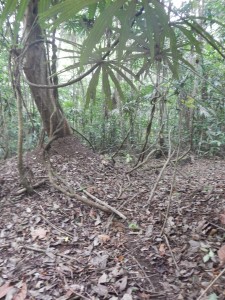We began our first real experiments bright and early this morning on the cecropia, or trumpet tree, which is known for its mutualistic relationship with Azteca ants. The hollow tree tunk provides shelter for the ants, and, in exchange, the ants defend against herbivores vying for the cecropia’s lobe-shaped leaves. Though cecropia’s mutalism with ants is incredibly effective, young cecropia trees are not yet colonized. How, then, do these juvenile trees protect themselves from herbivory?
We hypothesized that young cecropia use chemical defenses (like toxins or pheromones) to deter herbivores. Our pilot experiment involved collecting generalist herbivores, such as grasshoppers, and offering them both adult and juvenile cecropia leaves. We may not have the technology for chemical analysis here, but we do have sophisticated pieces of equipment like Tupperware and a butterfly net. We’ll see tomorrow if the insects opt to consume one leaf over the other, or even die after ingesting a toxic leaf.

The day’s ant theme continued with an afternoon dedicated to the fascinating life history of leaf-cutter ants. We looked at three leaf-cutter ant nests ranging from 1 to 10+ years old, observing their intricate tunnel systems and foraging trails. I was most amazed by the anthropomorphic qualities of leaf-cutter ants; they essentially act as farmers by cultivating fungus for food. The afternoon’s primary goal was uncovering these fungus gardens, which can sustain colonies of millions of ants.
Our focus today made reptile sightings difficult, as snakes and lizards are unlikely to be found in the vicinity of a large ant’s nest. Though we walked many of the same trails as yesterday, I wasn’t able to spot any of the Sumichrast’s skinks found yesterday in the leaf litter. I actually found better luck indoors today, spotting another common house gecko (Hemidactylus frenatus) running along the walls of our classroom.
